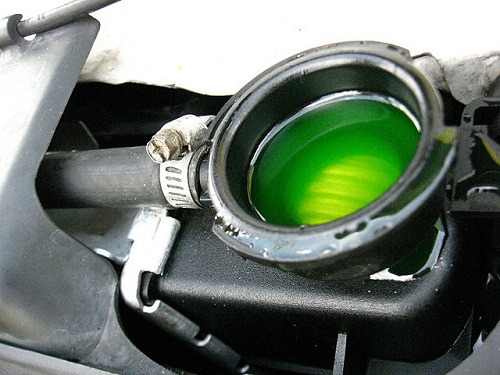The Difference between Antifreeze and Coolant

Antifreeze or coolant is a necessity in your vehicle. It changes the freezing and boiling properties of your engine water, protecting against harsh weather.
But there is no difference. That’s what a lot of people say.
Those people are wrong (well, sort of).
There is one, slight difference. There’s also a lot of interesting information about antifreeze one should know. This is especially true if you do your own maintenance.
The Difference
First things first. This is why you’re here, right?
Antifreeze is what you get in the bottle at the store. You pour your Antifreeze into the engine water, and you’ve got coolant.
It’s as simple as that. Despite the name, Antifreeze is both a coolant and an anti-freezing agent. While there is a lot of confusion around the subject, mechanics seem to agree that the above description is correct.
There’s a lot to know about Antifreeze. If you do want more of this interesting information, read on.
How to
Drain your engine water. This is usually done by disconnecting the lower-most pipe that’s connected to the radiator.
Once drained, unscrew your water cap and pour water and antifreeze inside. The recommended ratio is 50% water 50% antifreeze. If you know the capacity of your water system, you can hit this ratio. If not, then it might be wise to pre-mix the solution before pouring it into your vehicle.
Also don’t forget to reconnect the pipe on the radiator before you pour. This happened to me once – not with antifreeze, but with oil. It was quite a mess.
Make sure to reconnect and screw everything back on before starting the engine. Allow to idle for a few minutes to give the coolant time to circulate. Once well-circulated, check your water level again and top up as necessary.
Precautions
The main ingredient in antifreeze is Glycol, which is very dangerous. Animals and humans alike are in danger.
Ethylene glycol is more commonly used in antifreeze. Propylene glycol is more expensive to manufacture, but less toxic. Propylene is becoming more common, however.
Antifreeze should always be recycled or disposed of safely, as it can decimate aquatic populations. It can also disrupt sewer line treatment processes.
Pets
Antifreeze smells sweet. Therefore pets might mistake it for something yummy and chug away while you’re not looking. Keep antifreeze well away from pets.
If your pet displays any of the following symptoms, get them to a vet immediately.
- Lethargy
- Disorientation
- Bad co-ordination
- Grogginess
If treated quickly enough, a pet can survive a dose of antifreeze.
Children
Small children can easily mistake the sweet scent of antifreeze as a nice, sugary drink. If you suspect your child has swallowed antifreeze, or displays any of the below symptoms, get them to a doctor or hospital immediately.
- Nausea
- Abdominal pain
- Vomiting
- Kidney pain
- Dizziness
- Drunkenness
- Rapid breathing / shortness of breath
- Frequent or painful urination
There are more, but for the full sheet and some more info on the adverse health effects of antifreeze, see below references.
Please take care.
- The Difference between Trello and Evernote - July 13, 2017
- Difference between iCloud Drive and Dropbox - July 13, 2017
- Difference between Garmin Vivofit 2 and Fitbit Charge - July 13, 2017
Search DifferenceBetween.net :
Leave a Response
References :
[0]Facts about antifreeze - http://www.eetcorp.com/antifreeze/antifreeze-about.htm
[1]Pet poisoning - http://www.humanesociety.org/animals/resources/tips/antifreeze.html?referrer=https://www.google.co.za/
[2]Human poisoning - http://www.healthhype.com/antifreeze-poisoning-in-humans-signs-and-symptoms.html
[3]More Facts - https://www.kseal.com/expert-advice/difference-between-coolant-antifreeze
[4]https://en.wikipedia.org/wiki/Antifreeze
